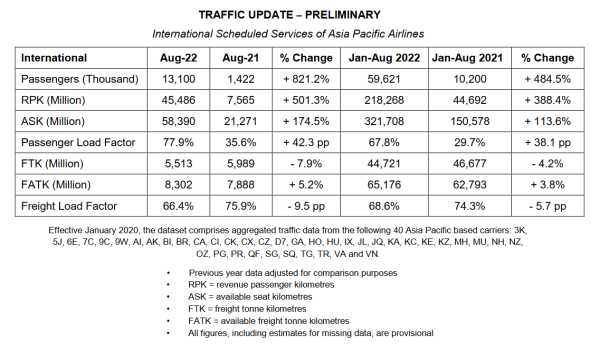KUALA LUMPUR, 4 October 2022: Preliminary August 2022 traffic figures released today by the Association of Asia Pacific Airlines (AAPA) showed robust recovery in international air passenger markets as pent-up travel demand continued to drive growth, despite increasingly challenging global economic conditions.
In August, the region’s airlines carried 13.1 million international passengers, compared to just 1.4 million recorded in the same month last year. Overall, this amounted to 39% of pre-pandemic 2019 levels. As measured in revenue passenger kilometres (RPK), demand grew by 501.3%, while available seat capacity was up by 174.5% compared to a year ago. As a result, the international passenger load factor jumped by 42.3 percentage points to an average of 77.9% for the month.

Meanwhile, demand for exports waned, further dampening air cargo markets. As a result, August saw international air cargo demand, in freight tonne kilometres (FTK), decline by 7.9% year-on-year. On the other hand, offered freight capacity expanded by 5.2%, with the ongoing recovery in commercial passenger operations adding available bellyhold space. This led to a sharp 9.5 percentage point fall in the average international freight load factor to 66.4% in August.
AAPA director general Subhas Menon commented on the results: “The healthy growth in international passenger traffic in the first eight months of the year shows strong travel demand from business and leisure sectors, even as persistently high inflation curtailed spending elsewhere.”
Menon added, “After more than two painful years into the pandemic, the region’s carriers are finally beginning to see some relief with the continuing upswing in passenger revenue, even as the cargo business remains weakened. Although cost pressures driven by high jet fuel prices and currency weakness have not abated, the rebound in travel markets will help improve regional airline earnings performance.”
Looking ahead, Menon concluded: “Amid an increasingly gloomy macroeconomic outlook, the lifting of travel restrictions in the major North Asian markets of Japan, South Korea and Hong Kong will hasten the pace of the industry’s return to health while full recovery is not expected until China is also open. The cooperation of all stakeholders is key to facilitating a smooth recovery in air travel.”






